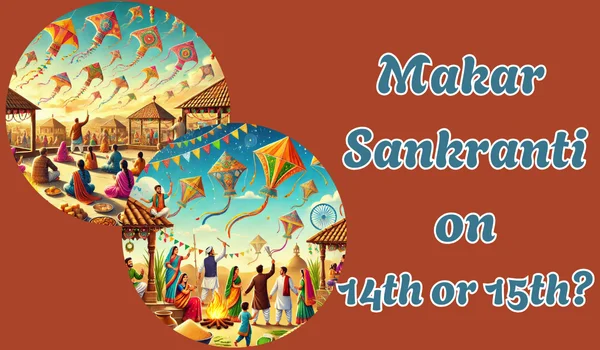Makar Sankranti, one of the most auspicious Hindu festivals, heralds the end of the winter solstice and the transition of the Sun into the zodiac sign of Capricorn (Makara). Celebrated with great enthusiasm across India, this festival signifies new beginnings, the arrival of longer days, and the harvesting season. However, this year, the exact date of Makar Sankranti—whether January 14 or 15—has become a topic of debate, leaving many devotees and celebrants uncertain.
The Astronomical Basis of Makar Sankranti
Unlike other Hindu festivals that follow the lunar calendar, Makar Sankranti is based on the solar calendar and marks the Sun’s movement into the Capricorn zodiac, also known as the winter solstice transition. This astronomical event, called the “Sankranti,” signifies the Sun’s northward journey, or Uttarayan, which is considered highly auspicious in Hindu tradition.
Typically, Makar Sankranti falls on January 14, but due to variations in the Earth’s rotation and tilt, as well as minute differences in the solar calendar, the festival date sometimes shifts to January 15. These slight shifts are influenced by the phenomenon known as the precession of the equinoxes, which alters the solar calendar alignment over centuries.
Why the Confusion in 2025?
In 2025, the Sun’s transition into Capricorn is set to occur late on January 14, around 10:02 PM IST. As per Hindu traditions, the exact timing of Sankranti determines the most auspicious period, also known as the Punya Kaal, for prayers, rituals, and celebrations. Since the transition occurs late in the evening on January 14, many astrologers and scholars have suggested observing the festival on January 15, when the Sun will have fully entered Capricorn.

This difference in interpretation—whether to observe the festival based on the actual transition time or the following day when the auspicious period aligns with daylight hours—has led to the current debate.
Official Observations and Regional Variations
The date of Makar Sankranti varies slightly across regions, reflecting local customs and traditions:
- January 14: Many regions, including Maharashtra, Gujarat, and Rajasthan, are likely to celebrate Makar Sankranti on January 14, aligning with the historical precedence of observing the festival on this date.
- January 15: States such as Tamil Nadu (where it is celebrated as Pongal) and parts of southern India may shift celebrations to January 15 due to the late timing of the Sun’s transition.
Auspicious Timings for Makar Sankranti 2025
For those observing Makar Sankranti based on the Punya Kaal, here are the key timings:
- Punya Kaal (Auspicious Period): January 15, from 7:15 AM to 12:30 PM.
- Mahapunya Kaal (Highly Auspicious Period): January 15, from 7:15 AM to 9:15 AM.
These timings are derived from traditional Panchang (Hindu almanacs) and consider the most propitious moments for performing rituals, offering prayers, and taking holy dips in sacred rivers.
How Makar Sankranti is Celebrated
Makar Sankranti is a pan-Indian festival celebrated in diverse forms across states:
- Kite Flying: In Gujarat and Rajasthan, the skies are adorned with colorful kites, symbolizing joy and competition. The International Kite Festival in Gujarat is a major attraction.
- Pongal in Tamil Nadu: The festival is celebrated as Pongal in Tamil Nadu, a four-day harvest festival marked by elaborate rituals, preparation of the sweet dish Pongal, and gratitude to farmers and cattle.
- Lohri in Punjab and Haryana: In northern India, the festival is associated with Lohri, celebrated a day before Makar Sankranti with bonfires, folk songs, and dancing.
- Holy Dips and Prayers: In states like Uttar Pradesh, Bihar, and West Bengal, devotees take holy dips in rivers like the Ganga, Yamuna, and Godavari to cleanse their sins and seek blessings.
- Sesame and Jaggery: Across most regions, delicacies made of sesame (til) and jaggery (gur) are prepared and distributed, symbolizing the warmth and sweetness of human relationships.
Significance of Makar Sankranti
Makar Sankranti is more than just a festival; it holds deep spiritual and agricultural significance:
- Seasonal Transition: It marks the Sun’s movement into the northern hemisphere, symbolizing longer days and the end of harsh winters.
- Agricultural Importance: The festival coincides with the harvest season, making it a time for farmers to celebrate their hard work.
- Spiritual Renewal: Hindus consider Uttarayan a highly auspicious period for beginning new ventures, performing charitable acts, and seeking divine blessings.
What Should Devotees Do?
Regardless of the date chosen for celebrations, the spirit of Makar Sankranti remains the same. Devotees are encouraged to:
- Perform rituals and offer prayers during the Punya Kaal on January 15.
- Share traditional sweets made of sesame and jaggery, symbolizing unity and harmony.
- Take a holy dip, if possible, and engage in charitable acts.
Conclusion
The debate over whether Makar Sankranti 2025 falls on January 14 or 15 reflects the festival’s alignment with precise astronomical events and regional traditions. While the exact date may vary, the essence of the festival—celebrating new beginnings, gratitude, and community—remains universal. Whether observed on January 14 or 15, Makar Sankranti serves as a reminder of India’s rich cultural diversity and the unifying spirit of its traditions.

Hello, I’m Kapil Kumar, a seasoned SEO expert and blogger at WinnersList.in. My mission is to spotlight exceptional individuals and organizations across various domains. Through curated lists, profiles, and inspiring stories, I aim to celebrate outstanding achievements and inspire the next generation of champions. Join me in this journey.
